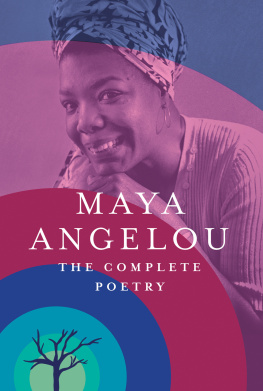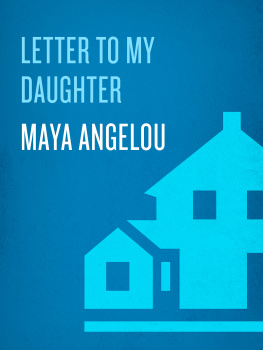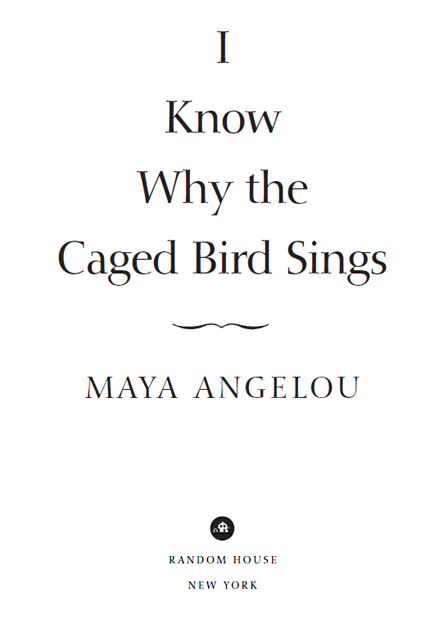2015 Random House Trade Paperback Edition
Copyright 1969 by Maya Angelou
Copyright renewed 1997 by Maya Angelou
Reading group guide copyright 2009 by Random House, Inc.
Foreword copyright 2015 by Oprah Winfrey
All rights reserved.
Published in the United States by Random House, an imprint and division of Random House LLC, a Penguin Random House Company, New York.
R ANDOM H OUSE and the H OUSE colophon are registered trademarks of Random House LLC.
Originally published in hardcover in the United States by Random House, an imprint and division of Random House LLC, in 1969.
The title I Know Why the Caged Bird Sings is from the poem "Sympathy" by Paul Laurence Dunbar.
LIBRARY OF CONGRESS CATALOGING-IN-PUBLICATION DATA
Angelou, Maya
I know why the caged bird sings / Maya Angelou.
p. cm
Originally published: c1969
ISBN 978-0-8129-8002-8
eBook ISBN 978-1-5883-6925-3
1. Angelou, MayaChildhood and youth. 2. Angelou, MayaHomes and hauntsArkansas. 3. Authors, American20th centurybiography.
4. African American women authorsbiography. 5. EntertainersUnited
StatesBiography. 6. African American familiesArkansas.
7. ArkansasSocial life and customs. I. Title
PS3551.N464 Z466 2002
818.5409dc21 2001041914
[B]
www.atrandom.com
Cover design: Rachel Ake, adapted from the original design by Janet Halverson
v3.0_r7
Contents
FOREWORD
Oprah Winfrey
I was fifteen years old when I discovered I Know Why the Caged Bird Sings. It was a revelation. I had been a voracious reader since the third grade, yet for the first time, here was a story that finally spoke to the heart of me. I was in awe. How could this author, Maya Angelou, have the same life experiences, the same feelings, longings, perceptions, as a poor black girl from Mississippias me?
I marveled from the first pages:
What you looking at me for?
I didnt come to stay
I just come to tell you, its Easter Day.
I was that girl who had recited Easter piecesand pieces of Christmas poems, too. I was that girl who loved to read. I was that girl raised by my Southern grandmother. I was that girl raped at nine, who muted the telling of it. I understood why Maya Angelou remained silent for years.
I bonded with her every word.
Each page revealed insights and feelings I had never been able to articulate. I thought, Heres a woman who knows me, who understands. I Know Why the Caged Bird Sings became my talisman. As a teenager, I tried convincing everyone I knew to read it. Its author was now my favorite author, someone I idolized from afar.
I knew it was Providence when, more than ten years later, as a young reporter in Baltimore, I was given the opportunity to interview Maya Angelou after her lecture at a local college. I promise, I insisted, "I promise if youll just let me speak with you, I wont take more than five minutes of your time." As good as my word, at 4:58 I told the cameraman, "Done." Which was when Maya Angelou turned her head, angled it to the side, and with a twinkle in her eye smiled at me and asked, "Who are you, girl?"
First we became friendly, then we became sister friends. When she finally told me I was her daughter, I knew I had found home.
Sitting at her kitchen table on Valley Road in Winston-Salem, North Carolina, listening to her read poetry, the poetry of my childhoodPaul Laurence Dunbar, "Little brown baby wif spaklin eyes"that was my favorite place to be: at the kitchen table, or sitting at her feet, leaning over her lap, laughing out loud for real. Soaking up all the knowledge, all the things she had to teachthe grace, the love, all of itmy heart was full when I was with her. Rarely did we ever have a phone conversation during which I didnt take notes. She was always teaching. "When you learn, teach," she said frequently. "When you get, give." I was a devoted student, learning from her up to the moment of our very last conversation, on the Sunday before she died. "I am a human being," she would always say, "therefore nothing human is alien to me."
Maya Angelou lived what she wrote. She understood that sharing her truth connected her to the greater human truthsof longing, abandonment, security, hope, wonder, prejudice, mystery, and, finally, self-discovery: the realization of who you really are and the liberation that love brings. And each of those timeless truths unfolds in this first autobiographical account of her life.
Im so pleased (and I know she is, too) that an entire new generation of readers will get to know Maya Angelous story and be better empowered to realize their own.
If youre a first timer (as I was so many years ago) or revisiting an old friend (which is how I feel, returning to these pages), youll notice that even as a young writer, Maya delivered the theme that prevails throughout this book, the theme that became her siren call, a mantra that would resonate throughout all her speeches, her poems, her worksand her life.
She spoke proudly, bodaciously, and often:
We are more alike than we are unalike!"
That truth is why we can all have empathy, why we can all be stirred when the caged bird sings.
I Know Why the Caged Bird Sings
What you looking at me for?
I didn't come to stay
I hadn't so much forgot as I couldn't bring myself to remember. Other things were more important.
What you looking at me for?
I didn't come to stay
Whether I could remember the rest of the poem or not was immaterial. The truth of the statement was like a wadded up handkerchief, sopping wet in my fists, and the sooner they accepted it the quicker I could let my hands open and the air would cool my palms.
What you looking at me for ?
The children's section of the Colored Methodist Episcopal Church was wiggling and giggling over my well-known forgetfulness.
The dress I wore was lavender taffeta, and each time I breathed it rustled, and now that I was sucking in air to breathe out shame it sounded like crepe paper on the back of hearses.
As I'd watched Momma put ruffles on the hem and cute little tucks around the waist, I knew that once I put it on I'd look like a movie star. (It was silk and that made up for the awful color.) I was going to look like one of the sweet little white girls who were everybody's dream of what was right with the world. Hanging softly over the black Singer sewing machine, it looked like magic, and when people saw me wearing it they were going to run up to me and say, Marguerite [sometimes it was dear Marguerite], forgive us, please, we didn't know who you were, and I would answer generously, No, you couldn't have known. Of course I forgive you.
Just thinking about it made me go around with angel's dust sprinkled over my face for days. But Easter's early morning sun had shown the dress to be a plain ugly cut-down from a white woman's once-was-purple throwaway It was old-lady-long too, but it didn't hide my skinny legs, which had been greased with Blue Seal Vaseline and powdered with the Arkansas red clay. The age-faded color made my skin look dirty like mud, and everyone in church was looking at my skinny legs.
Wouldn't they be surprised when one day I woke out of my black ugly dream, and my real hair, which was long and blond, would take the place of the kinky mass that Momma wouldn't let me straighten? My light-blue eyes were going to hypnotize them, after all the things they said about my daddy must of been a Chinaman (I thought they meant made out of china, like a cup) because my eyes were so small and squinty Then they would understand why I had never picked up a Southern accent, or spoke the common slang, and why I had to be forced to eat pigs' tails and snouts. Because I was really white and because a cruel fairy stepmother, who was understandably jealous of my beauty, had turned me into a too-big Negro girl, with nappy black hair, broad feet and a space between her teeth that would hold a number-two pencil.









